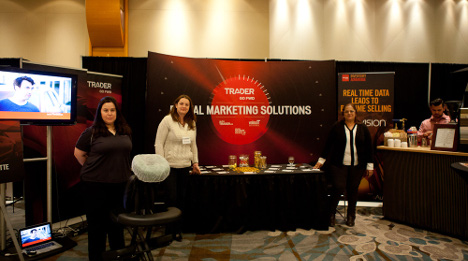Using Consumer Data To Merchandize, Boost Online Rep

TRADER shared market insight from the Expo Hall, as well, at last week's Auto Remarketing Canada Conference in Toronto. Photo Credit: Michelle Yee.
As more and more car shoppers turn to the Web for their car-shopping needs — on a myriad of mobile devices — consumer data is becoming increasingly more important to successfully target and attract these potential customers.
Robert Rath, vice president of dealership products and business development at TRADER Corp., touched on this very issue at last week’s Auto Remarketing Canada Conference.
His presentation, titled, “Beating the Odds: How to Win with Consumers in the Digital Age,” focused on how consumer data can help you better connect with future buyers and figure out what consumers are looking for.
Auto Remarketing Canada caught up with Rath after his presentation at last week’s event, for a little more insight into why live market data is one of the “keys” for dealers looking to configure the right lot stock in relation to seasonality, geography and more.
Rath said compiling and studying consumer data or “big data” helps dealers figure out “what is going on in there market and helps to make sure they are pricing in line with their particular locale.”
Consumer data also comes into play when in merchandising and can help you figure out what cars shoppers are looking for in your area. But the work doesn’t end there.
“We know that good photos, good descriptions, and good video drive consumer conversion. Really, it’s a discipline thing — you have to do it for every car, not just half the cars,” Rath said.
Lastly, consumer data tells you where consumers are and what devices they are using.
“So, if you’re not in a mobile ready website, consumers are not going to find you when they are out and about,” Rath added.
Rising Above Competition
Another key element from Rath’s presentation was how to “beat the odds,” or rise above competition online.
In this market, digital marketing can help dealers of all sizes — Rath likened it to a “David and Goliath analogy” — regardless of size, dealerships can stand out if they play their digital cards right.
“So, the trick is how you make your message relevant to the consumer, and how you make sure your website and digital marketing efforts stand out,” said Rath.
He explained it’s all about using those digital marketing tools, and using them right.
“A consumer will respond to a well-timed offer or a well-timed point-of entry message, regardless of whether it’s from a small or large dealership,” Rath said.
“What does that mean to me? It means that in terms of beating the odds, it’s about recognizing that big data is there, and it’s not going away; recognizing that you have the tools and capability to deal with it,” said Rath.
But if you are a smaller dealership, consumer data may be a hard beast to tackle, because you may not have a full-time marketing manager.
Then, “beating the odds” might be more about choosing partners.
“Same as you wouldn’t design a house without an architect, because it’s complicated. Digital marketing is in some degrees very similar. It is about what channel to use in a fragmented market, and which message should go to the consumer, and partners can help with that,” Rath said. “It’s about the tools you use, the support you have for those tools, and which partners you use.”
Coming ‘Back to the Basics’
Dealers can make the Internet work in their favor, but to do so as successfully as possible, dealers need to come back to the digital marketing basics.
“Use the information and consumer data available to make sure you have got the cars you need. Make sure you price the cars correctly for your market, but also merchandise them properly,” Rath said. “So, this comes back to the discipline … making sure you have 10 to 14 photos for every car on your lot, making sure you have got good descriptions, and maybe putting a video up. Those these sound mundane, consumers respond very well to good merchandizing.”
Dealers can waste money very quickly with large search engine marketing campaigns, especially if when the consumer actually comes to your website, they can’t find the car they need, or there aren’t any pictures or full descriptions.
“So, to some degree, content is key,” Rath said.
And another simple way to gain traction on the Web is dealer reviews, especially in a market increasingly dominated by millennials.
“We know that dealer reviews on your site is a great search engine optimization tool. And that Gen Y will actively seek out dealers that have reviews on their site,” Rath said. “So, it’s really simple, doesn’t cost you a lot of money, and it is a great service from your existing customers, as well as your future customers. So, if there are two dealers in similar geography with similar inventory, Gen Y will go to the one with reviews.”
It’s about online reputation, and how consumers perceive your store’s image on the Web.
And part of fostering that reputation is ensuring consistency and communication across all Web channels, as well as in your physical store, or as Rath puts it, “you have to line up your digital lot with your physical lot.”
“Again, it’s about linking your digital presence with your physical presence and making sure that if you make an offer to the consumer, you deliver on that offer,” Rath added.
For example, there is no point spending a lot of money on a website that has an instant chat capability or a referral capability if there is no one on the other end of the chat, or there is no one responding to email.
“If you offer the service, you have to deliver it. We know that the conversion rate to sale is much higher the faster you respond to a consumer lead. So, the longer you let the lead go cold, the consumer has grown impatient and has gone to the dealer down the road,” Rath concluded.
For more insight on digital marketing trends, see the most recent edition of the Auto Remarketing Canada Digital Magazine.


